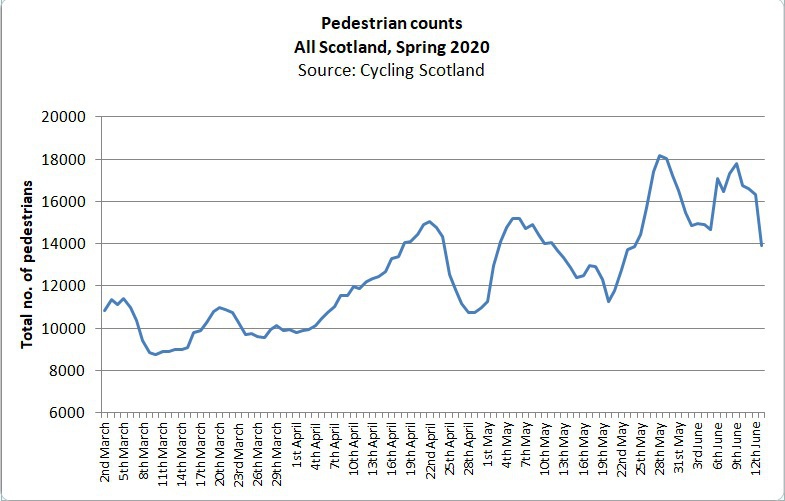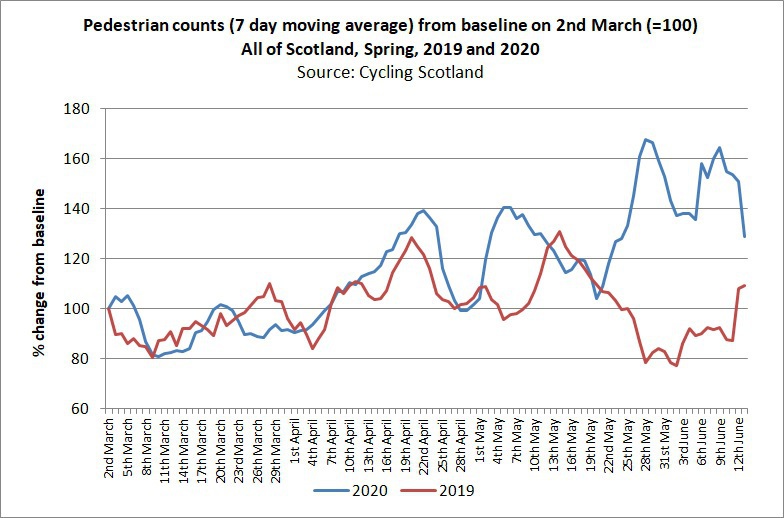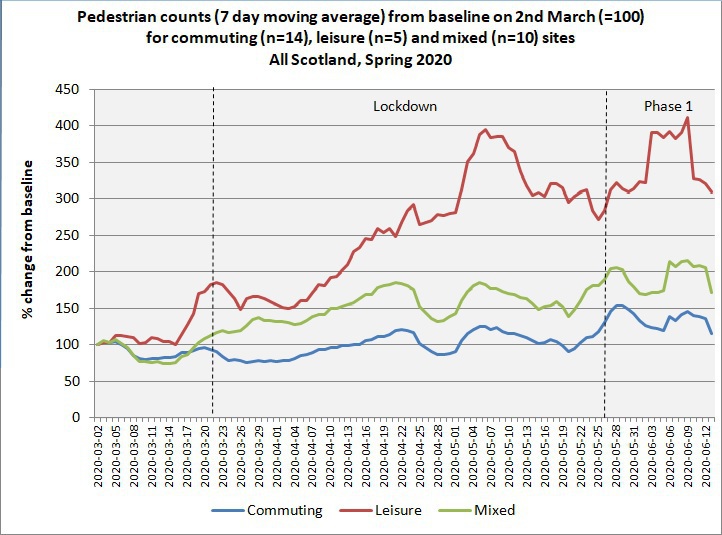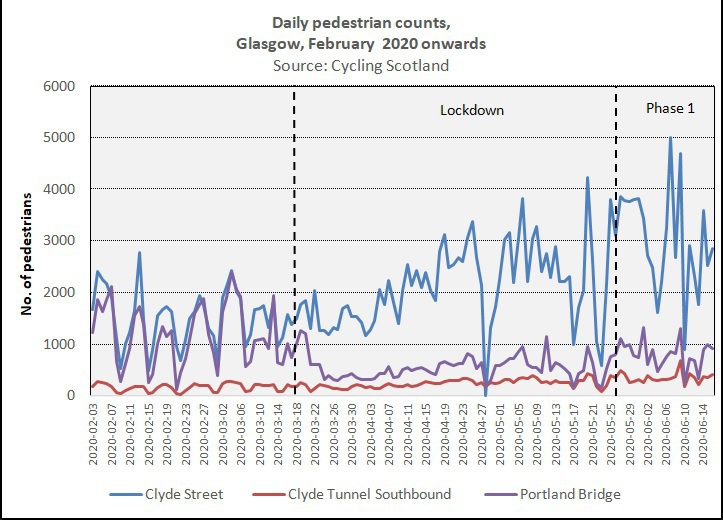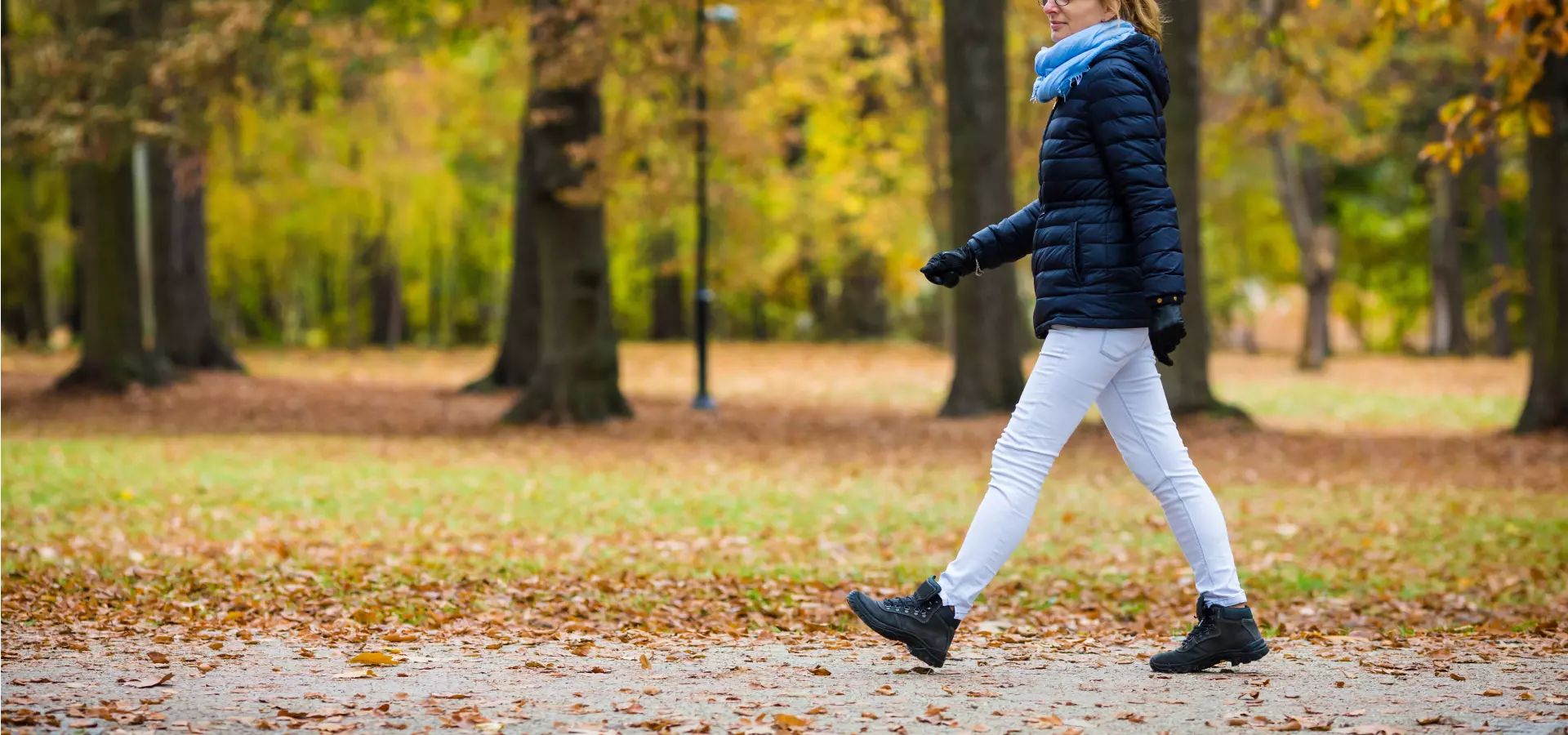
Walking during the lockdown in Scotland
We recently analysed data from Cycling Scotland that showed a dramatic increase in cycling across Scotland during lockdown. We’re following up on that analysis with a look at data on pedestrians at various sites across Scotland, over the course of lockdown and into Phase 1 of the lifting of restrictions.
While cycling has seen a significant upsurge in recent months, walking is an equally important form of active travel, particularly over shorter distances and as a leisure pastime. For those who do not have access to a bike or cycling infrastructure, or who are more confident or prefer to walk, it is a crucial form of exercise known to benefit both physical and mental health.
What data did we use?
As well as cyclists, Cycling Scotland record counts of pedestrians at around 40 of their 60 cycling monitoring sites. Since the beginning of March this year, 29 of those sites (from across 14 local authorities) have provided enough data for us to analyse changes in patterns of pedestrian traffic during lockdown and into Phase 1 of the lifting of restrictions. During Phase 1, people were permitted to meet up with another household outdoors, as long as they remained socially distant.
It is worth noting that although this data is extremely useful for comparing counts of pedestrians and cyclists, the recording sites are not evenly distributed across Scotland and just over half of Scotland’s local authorities are not represented. They also tend to be placed in locations where the primary interest is in recording cycling traffic. These data are, nevertheless, useful in giving an overall impression of the numbers of walkers in various places across the country.
What did the data show?
Graph 1 below shows the overall trend in the number of walkers was upwards over the course of the lockdown (23rd March – 27th May) and generally remained high during Phase 1 of the lifting of lockdown restrictions (28th May – 17th June). There were some notable low points around the last week in April and the third week in May, which broadly aligned with periods of wetter and more unsettled weather. Perhaps unsurprisingly, and as with cycling, poorer weather appears to have had a negative impact on people’s desire to go out for a walk!
Although the general trend of this graph is upwards, we might arguably expect to see this from the end of winter to the start of summer in any given year, as the weather generally improves. To better understand the impact of lockdown itself, we took 2nd March as a baseline and compared the relative number of walkers in 2019 and 2020, to see if there were any differences. We also compared this with cycling trends over the same periods and this is shown in Graph 2 and Graph 3 below.
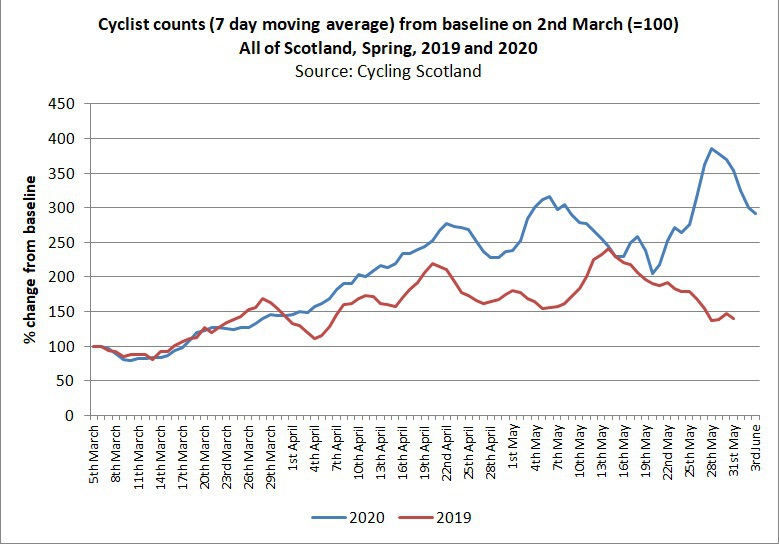 As we can see, there is much less of a general upward trend in the number of walkers across 2019, when compared with this year. This is also the case for cycling, although to a much greater extent. This suggests that lockdown has impacted on people’s engagement in walking (and cycling) and this has probably been helped by the generally fine and dry weather we have had this Spring.
As we can see, there is much less of a general upward trend in the number of walkers across 2019, when compared with this year. This is also the case for cycling, although to a much greater extent. This suggests that lockdown has impacted on people’s engagement in walking (and cycling) and this has probably been helped by the generally fine and dry weather we have had this Spring.
Have we seen more commuting or leisure walkers?
We were also interested in whether changes in the number of walkers were different at different types of location. For example, were more people walking to a place of work in order to avoid public transport, or were they taking a greater number of leisure walks? To explore this, we classified each of the Cycling Scotland sites by whether they were mainly measuring commuting walkers, leisure walkers or a mixture of both during 2019. The method we used to do this is described in our previous cycling blog.
Graph 4 suggests that while walking at commuting sites rose relatively little during lockdown, walking at leisure sites increased considerably. In early May and early June, the number of people walking at these sites was around four times the level in early March, before lockdown began. These high levels of walking at leisure sites have remained elevated during Phase 1 of the lifting of restrictions, while walking at both commuting and mixed sites has increased too.
Commuting patterns in more detail
Although the number of walkers at commuting sites did not increase as substantially as those at leisure sites, the weekly pattern of traffic did change significantly. Graph 5 below shows the number of walkers at three inner-city Glasgow sites, from the start of February to mid-June.
Before lockdown began, there were distinct peaks during the week and troughs at the weekend at these sites. During both lockdown and Phase 1, this has given way to a much more erratic weekly pattern of traffic. While this may be driven by alternative commuting patterns, it is perhaps more likely that these sites are being used not by walkers on their commute, but by those going shopping or leisure walking at these sites during this time.
What does this mean?
In planning active travel infrastructure for Phases 2, 3 and beyond, it is important to consider how patterns and levels of pedestrian traffic might change as restrictions are lifted. A recent report by Transform Scotland makes a number of recommendations to help us ‘lock-in’ the substantial increases in active travel we have seen during lockdown, for both walkers and cyclists.
Walking for leisure, in particular, appears to have grown substantially in popularity throughout the period of lockdown and remained high during Phase 1. With almost two thirds of respondents to a recent Travel Scotland survey stating that they will walk or cycle more once restrictions on travel are lifted, we must do everything we can to encourage, support and maintain this increase in walking (and cycling) over the longer term and the health and wellbeing benefits this brings.
